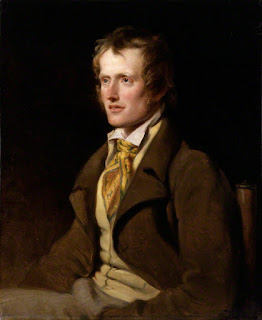John Clare's Captivating Portrayal of Serene Beauty of the Countryside
John Clare, "the Northamptonshire Peasant Poet"(1793-1864), is celebrated for his vivid portrayals of the English countryside and his poignant expressions of its disturbance. Among his notable collections of poetry, such as "First Love," "Snow Storm," and "The Village Minstrel and Other Poems," Clare captures the essence of the English countryside with a fresh air of romanticism. His "Autumn" transports us to the serene countryside, where he explores the subtle and mellow beauty of the autumnal season, a season characterized by falling leaves, bare branches, and vigorous winds as it serves as a prelude to winter. Through his descriptive language and keen observations, the poet paints a vivid pen picture of autumn's charm.
 |
| John Clare |
The Melancholic Beauty of Autumn's Dance
A Juxtaposition of Seasons: Nostalgia and Longing
Clare's attention then turns to the shaking twigs that dance until evening sets in. He notices a sparrow perched on a cottage ridge, whose cheerful chirping makes one believe that spring is still present, nestled within the lap of summer. This juxtaposition of seasons conveys a sense of nostalgia and longing, as autumn's arrival brings forth the memories of the vibrant and blossoming days of spring:
Autumn's Serene Solitude and Rustic Charm
The poet's focus shifts to the cottage smoke curling upwards amidst the naked trees. He observes the pigeons seeking solace in their cozy nooks on dull November days. These scenes depict the quietude and solitude that autumn brings, as nature prepares for the arrival of winter. The imagery of the cock crowing on the dung-hill and the mill sails turning on the heath adds to the sense of rustic charm and the passing of time:
Nature's Rhythmic Transformations in Autumn
Clare then introduces natural elements associated with autumn, such as the feather falling from a raven's breast onto the stubble field. This delicate image emphasizes the gentle touch of nature as it gradually transforms the landscape. The falling acorns near the old crow's nest further accentuate the rhythmic pattern of nature's cycles. The grunting pigs eagerly scramble and hurry to feast upon the fallen acorns, embodying the instinctual drive for survival and sustenance:
Falls on the stubble lea
The acorns near the old crows nest
Fall pattering down the tree
The grunting pigs that wait for all
Scramble and hurry where they fall"
Descriptive Language and Imagery
Throughout the four stanzaic poem, Clare employs descriptive language and imagery to evoke the tranquility and subtle beauty of autumn. His choice of words allows readers to visualize the scenes and immerse themselves in the countryside's harmonious atmosphere. The repetition of natural sounds, such as the shaking twigs and the crowing of the cock, adds an auditory dimension to the poem, further enhancing its evocative power. Added to that the rhyming of ababcc, the repeated rhyme scheme contributes to the poem's overall musicality and creates a sense of harmony and rhythm.
Conclusion
In conclusion, John Clare's "Autumn" captures the serene tapestry of nature's beauty in the countryside. Through his keen observations and descriptive language, the poet immerses us in the delicate charm of the season. The poem's themes of change, nostalgia, and the cyclical nature of life remind us of the fleeting yet enchanting qualities of autumn. Clare's ability to paint a pen picture of the mellow beauty of autumn in the countryside allows readers to appreciate the quiet magnificence that resides within this transitional season.
References
1. Poem of the week: Autumn by John Clare. (2012, October 29). The Guardian. http://www.theguardian.com/books/2012/oct/29/poem-of-the-week-john-clare
2. John Clare - Wikipedia. (2019, August 26). John Clare - Wikipedia. https://en.wikipedia.org/wiki/John_Clare#:~:text=John%20Clare%20(13%20July%201793,a%20major%2019th%2Dcentury%20poet.

Comments
Post a Comment
Drop any query, suggestion or comment here.